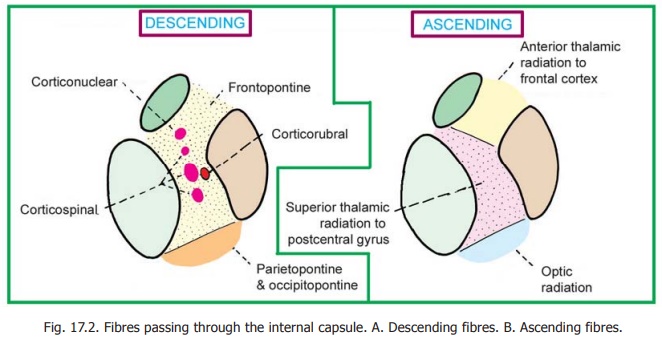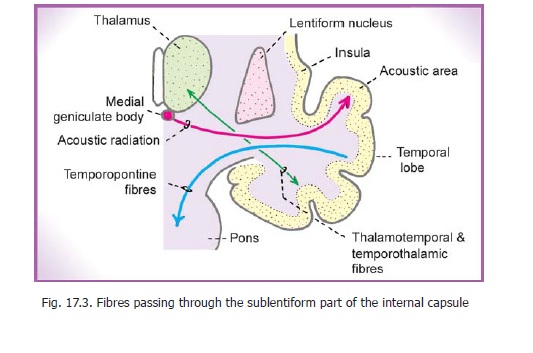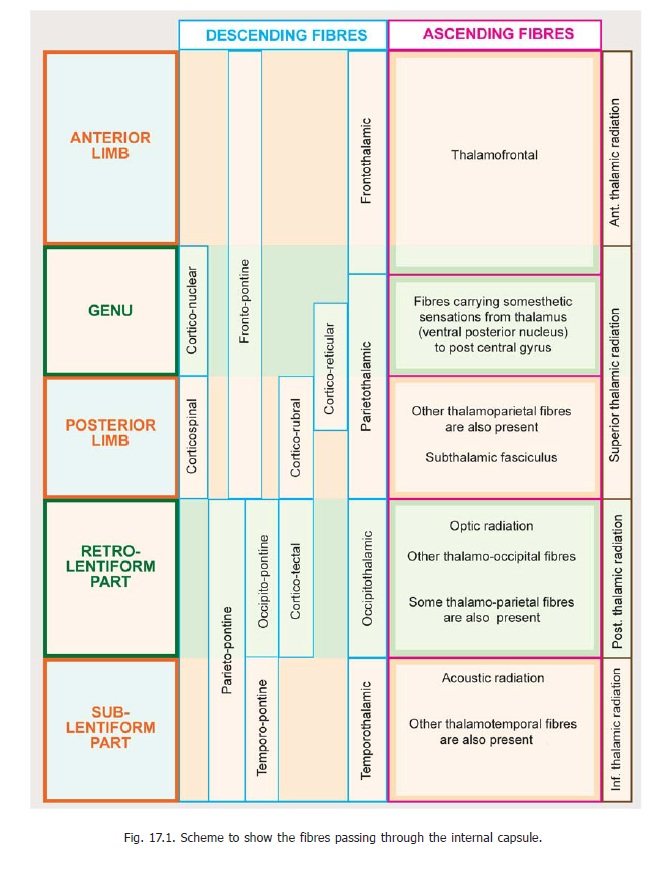Chapter: Human Neuroanatomy(Fundamental and Clinical): Internal Capsule and Commissures of the Brain
The Internal Capsule of the Brain

The Internal Capsule
A preliminary description of the internal capsule is given. This should be read before studying the details of the fibres passing through the capsule.
The fibres passing through the capsule may be ascending (to the cerebral cortex) or descending (from the cortex). The arrangement of fibres is easily remembered if it is realized that any group of fibres within the capsule takes the most direct path to its destination. Thus fibres to and from the anterior part of the frontal lobe pass through the anterior limb of the internal capsule. Those to and from the posterior part of the frontal lobe, and from the greater part of the parietal lobe, occupy the genu and posterior limb of the capsule. Fibres to and from the temporal lobe occupy the sublentiform part (Fig. 17.3), while those to and from the occipital lobe pass through the retrolentiform part. Some fibres from the lowest parts of the parietal lobe accompany the temporal fibres through the sublentiform part.

Ascending Fibres
These are predominantly thalamocortical fibres which go from the thalamus to all parts of the cerebral cortex (Figs. 17.1, 17.2B).
Fibres to the frontal lobe constitute the anterior thalamic radiation (or frontal thalamicpeduncle). They pass through the anterior limb of the internal capsule. The fibres arise mainly fromthe medial and anterior nuclei of the thalamus. The anterior thalamic radiation also carries fibres from the hypothalamus and limbic structures to the frontal cortex.


Fibres travelling from the ventral posterior nuclei of the thalamus to the somatosensory area (in the postcentral gyrus) constitute the superior thalamic radiation (or the superior, or dorsal,thalamic peduncle). These fibres occupy the genu and posterior limb of the capsule. It should benoted that these fibres are third order sensory neurons responsible for conveying somesthetic sensations to the cerebral cortex. The superior thalamic radiation also contains some fibres that go from the thalamus to parts of the frontal and parietal lobes adjoining the postcentral gyrus.
Fibres from the thalamus to the occipital lobe constitute the posterior thalamic radiation (or the posterior, or caudal, thalamic peduncle). This includes the optic radiationfrom the lateral geniculate body to the visual cortex. These radiations lie in the retrolentiform part of the internal capsule. The retrolentiform part also contains some fibres passing from the thalamus to the posterior part of the parietal lobe.
Fibres from the thalamus to the temporal lobe constitute the inferior thalamic radiation (or ventral thalamic peduncle). It includes the acoustic radiation from the medial geniculate bodyto the acoustic area of the cerebral cortex. These fibres pass through the sublentiform part of the internal capsule.
Descending Fibres
1.Corticospinal and corticonuclear fibres
Corticonuclear fibres (for motor cranial nerve nuclei) pass through the genu of the internal capsule (Figs. 17.1, 17.2A).
Corticospinal fibres form several discrete bundles in the posterior limb of the capsule. The fibres for the upper limb are most anterior, followed (in that order) by fibres for the trunk and lower limb.
2.Corticopontine fibres
Frontopontine fibres are the most numerous. They pass through the anterior limb, genu, and posterior limb of the internal capsule. Parietopontine fibres pass mainly through the retrolentiform part. Some fibres pass through the sublentiform part. Temporopontine fibres pass through the sublentiform part (Fig.17.3). Occipitopontine fibres pass through the retrolentiform part.
3.Corticothalamic fibres
These pass from various parts of the cerebral cortex to the thalamus. They form part of the thalamic radiations described above.
4.Fibres from Cerebral Cortex to Brainstem nuclei
a) Corticonuclear fibres to cranial nerve nuclei have been mentioned above.
b) Corticorubral fibres pass through the posterior limb.
c) Corticoreticular fibres pass through the genu and posterior limb.
d) Occipitotectal and occipitocollicular fibres pass through the retrolentiform part.
e) Fibres of the subthalamic fasciculus pass transversely through the posterior limb (intersecting the vertically running fibres). The fibres connect the subthalamic nucleus to the globus pallidus.
Clinical:
The blood supply of the internal capsule is described. Thrombosis in an artery supplying the internal capsule (cerebral thrombosis) leads to a stroke that results in hemiplegia. The opposite side of the body is affected. As the tracts passing through the internal capsule are closely packed even a small lesion can cause extensive paralysis. Sensations can also be lost. Reflexes are exaggerated as in a typical upper motor neuron paralysis. Rupture of one of the arteries leads to cerebral haemorrhage that is often fatal.
Related Topics